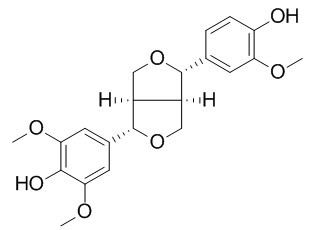Medioresinol
Medioresinol possesses antioxidative, a lesishmanicidal activity and cardiovascular disease risk reduction, it has antiamyloidogenic activity via reduction in the amount of β-secretase, it is a potentially valuable antiamyloidogenic agent for the prevention and treatment of Alzheimer disease. (+)-Medioresinol has anti-bacterial, antifungal and anti-biofilm activities.
Inquire / Order:
manager@chemfaces.com
Technical Inquiries:
service@chemfaces.com
Tel:
+86-27-84237783
Fax:
+86-27-84254680
Address:
1 Building, No. 83, CheCheng Rd., Wuhan Economic and Technological Development Zone, Wuhan, Hubei 430056, PRC
Providing storage is as stated on the product vial and the vial is kept tightly sealed, the product can be stored for up to
24 months(2-8C).
Wherever possible, you should prepare and use solutions on the same day. However, if you need to make up stock solutions in advance, we recommend that you store the solution as aliquots in tightly sealed vials at -20C. Generally, these will be useable for up to two weeks. Before use, and prior to opening the vial we recommend that you allow your product to equilibrate to room temperature for at least 1 hour.
Need more advice on solubility, usage and handling? Please email to: service@chemfaces.com
The packaging of the product may have turned upside down during transportation, resulting in the natural compounds adhering to the neck or cap of the vial. take the vial out of its packaging and gently shake to let the compounds fall to the bottom of the vial. for liquid products, centrifuge at 200-500 RPM to gather the liquid at the bottom of the vial. try to avoid loss or contamination during handling.
J Ethnopharmacol.2023, 309:116302.
Nutrients.2019, 12(1)
J Med Food.2019, 22(10):1067-1077
Eur J Pharm Sci.2016, 94:33-45
Mol Biol Rep.2023, 50(5):4029-4038.
Nutrients.2021, 13(3):978.
Nat Prod Sci.2018, 24(2):109-114
Phytomedicine.2018, 47:48-57
Food Res Int.2024, 197(Pt 1):115244.
Food Bioscience2023, 52:102412
Related and Featured Products
Appl Biochem Biotechnol. 2013 Aug;170(8):1934-41.
Synergistic antibacterial and antibiofilm effect between (+)-medioresinol and antibiotics in vitro.[Pubmed:
23797511 ]
METHODS AND RESULTS:
In this study, antibacterial effects of (+)-Medioresinol isolated from stem bark of Sambucus williamsii and its synergistic activities in combination with antibiotics such as ampicillin, cefotaxime, and chloramphenicol were tested by antibacterial susceptibility testing and checkerboard assay. (+)-Medioresinol possessed antibacterial effects against antibiotics-susceptible- or antibiotics-resistant strains. Most of combinations between (+)-Medioresinol and each antibiotic showed synergistic interaction (fractional inhibitory concentration index ≤ 0.5) against bacterial strains including antibiotics-resistant Pseudomonas aeruginosa. Furthermore, the antibiofilm effect of (+)-Medioresinol alone or in combination with each antibiotic was investigated.
CONCLUSIONS:
The results indicated that not only (+)-Medioresinol but also its combination with each antibiotic had antibiofilm activities. It concludes that (+)-Medioresinol has potential as a therapeutic agent and adjuvant for treatment of bacterial infection.
Biochimie. 2012 Aug;94(8):1784-93.
(+)-Medioresinol leads to intracellular ROS accumulation and mitochondria-mediated apoptotic cell death in Candida albicans.[Pubmed:
22534194]
The phytochemical (+)-Medioresinol, a furofuran type lignan identification and isolation on the stem bark of Sambucus williamsii, which is a folk medicinal plant used in traditional medicine. (+)-Medioresinol is known to possess a lesishmanicidal activity and cardiovascular disease risk reduction but its antifungal effects have not yet been identified.
METHODS AND RESULTS:
In this study, to confirm (+)-Medioresinol's antifungal properties and mode of action, we observed morphological and physiological change in Candida albicans. In cells exposed to (+)-Medioresinol, arrested the cell cycle and intracellular reactive oxygen species (ROS) which is a major cause of apoptosis were increased. The increase of ROS induced oxidative stress and the mitochondria dysfunction which causes release of pro-apoptotic factors. We investigated a series of characteristic cellular changes of apoptosis by using various apoptosis detection methods. We report here for the first time that (+)-Medioresinol has effects on mitochondria and induced the accumulation of ROS in C. albicans cells. we investigated the release of cytochrome c, which is one of the factors of metacaspase activity. We also show that the effects of (+)-Medioresinol are mediated at an early stage in apoptosis acting on the plasma membrane phosphatidylserine externalization. In addition, (+)-Medioresinol induced apoptotic morphological changes, showing the reduced cell size (low FSC) and enhanced intracellular density (high SSC). In late stage of confirmation of diagnostic markers in yeast apoptosis include the effects of nucleus morphological change, DNA fragmentation and condensation by influence of oxidative stress.
CONCLUSIONS:
These apoptotic phenomena represent that oxidative stress and mitochondria dysfunctions by inducing the phytochemical (+)-Medioresinol must be an important factors of the apoptotic process in C. albicans. These results support the elucidation of the underlying antifungal mechanisms of (+)-Medioresinol.
Nutr Res. 2016 Nov;36(11):1277-1284.
Phenylpropanoids from cinnamon bark reduced β-amyloid production by the inhibition of β-secretase in Chinese hamster ovarian cells stably expressing amyloid precursor protein.[Pubmed:
27865616 ]
β-Amyloid (Aβ) is a substance of Alzheimer disease (AD), which is generated via the amyloidogenic pathway from amyloid precursor protein (APP) by β-secretase and γ-secretase. Inhibition of Aβ production is a potential therapeutic approach to AD. Thus, we tested the hypothesis that cinnamon bark (Cinnamomi Cortex Spissus), the dried bark of Cinnamomum cassia Blume (Lauraceae), and its constituents are beneficial to AD.
METHODS AND RESULTS:
The methanol extract of cinnamon bark efficiently reduced Aβ40 production in Chinese hamster ovarian (CHO) cells stably expressing APP as determined by enzyme-linked immunosorbent assay. Bioassay-guided isolation of cinnamon bark extract was carried out using open column chromatography and high-performance liquid chromatography, and the following 6 phenylpropanoids were isolated: syringaresinol (1); Medioresinol (2); coumarin (3); 2-hydroxycinnamaldehyde (4); cryptamygin A (5); and 3',5,7-trimethoxy epicatechin (6). Among these, 4 μg/mL Medioresinol and cryptamygin A reduced Aβ40 production by 50% and 60%, respectively, compared with dimethyl sulfoxide-treated control cells. The IC50 values of Medioresinol and cryptamygin A for the inhibition of Aβ40 production were 10.8 and 8.2 μg/mL, respectively. Furthermore, treatment of APP-CHO cells with either compound decreased the amount of β-secretase and sAPPβ (the proteolytic fragment of APP catalyzed by β-secretase).
CONCLUSIONS:
These results suggest that the antiamyloidogenic activity of cinnamon bark extract was exerted by Medioresinol and cryptamygin A via a reduction in the amount of β-secretase. The extract of cinnamon bark contains potentially valuable antiamyloidogenic agents for the prevention and treatment of AD.



